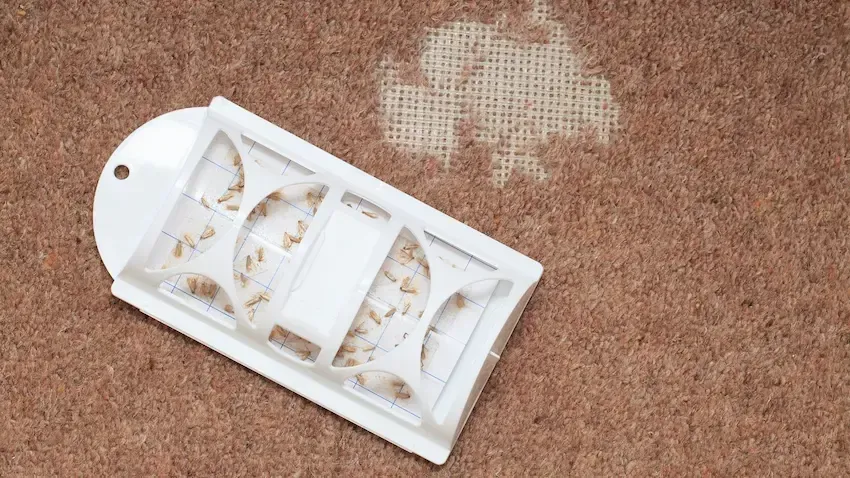Carpet pests: battling beetles, and managing moths
The thought of carpet beetles or carpet moths sharing your home is never going to be pleasant. These unwelcome squatters, while small, can be mighty destructive – tiny invaders that, if left untreated, can wreak havoc on your carpets, upholstery, and cherished fabrics until you find your cashmere sweater is tatty from holes. For Christchurch homeowners, understanding these resilient pests and knowing when it's time to call in the professionals is crucial to protecting your home.
Is it carpet beetle, or is it carpet moth?
Both carpet beetle and carpet moth (also called clothes moth) are prevalent in New Zealand, and much of what you need to know applies to both, including control and treatments. First of all, here are the differences:
- Carpet beetle larvae have a dark, hairy beetle appearance and move like beetles. They’re referred to as “woolly bears” but are truly not that cute!
- Carpet moth larvae live in portable silken cases, are less hairy and may leave behind their silken tubes, webs or cases as they mature. Both will travel to find food.
- Adult carpet beetles are small (2-3mm), oval, and dark coloured. adult carpet beetles tend to loiter near windows. While less harmful than larvae, they may indicate a breeding population, which is not good news. Carpet beetles have a long lifespan when compared to other NZ pests which means it’s crucial to take an Integrated Pest Management approach to disrupt their life cycle and prevent reinfestation.
- Adult carpet moths are larger, lighter in colour and have wings with distinct dots on their forewings. Although they have wings, they will often walk or hop/fly across surfaces. Not all moths that come indoors are carpet moths. Their purpose, once matured to adult beetles or moths, is to mate and lay more eggs – in your house! Adult carpet moths don’t eat fibres.
Spotting the signs of carpet pest infestation
Carpet beetles and moths are masters of disguise, often going undetected until significant damage has occurred, but even aside from live sightings there are telltale signs to be vigilant for:
- Damaged fabrics: look for irregular holes or bare patches in carpets, rugs, and upholstery. Damage may appear as clean-cut holes on some fabrics, or it may look like the fibres have thinned which can be mistaken for wear and tear.
- Shed skins: as carpet beetle larvae develop they molt, shedding their skin. These tiny, shell-like casings are found near infested areas and resemble small, dry husks.
Carpet moth larvae live in silken tubes or casings and will shed these as they mature.
- Faecal matter: small, granular droppings typically seen around areas of damaged materials can indicate carpet pest activity.
- Unusual worn areas: pay special attention to carpets under rarely moved furniture, inside wardrobes, and around the edges of rugs. There is no reason for carpets to look threadbare in these areas, and these undisturbed spots are prime carpet beetle and carpet moth real estate.

Materials at risk: what carpet pests love
Carpet pests are highly selective feeders, with a strong preference for natural fibres and protein-rich materials. Their larvae feed on keratin, a protein found in animal products, making wool, silk, fur, feathers, and leather especially vulnerable. Items made from these materials are susceptible in both residential and commercial environments.
Even blended fabrics aren’t safe. Carpets, rugs, and upholstered furniture containing a mix of natural and synthetic fibres can still attract carpet pests, particularly if the natural content is high. This makes many modern textiles at risk, even if they aren't 100% natural.
Beyond household fabrics, carpet pests have been known to cause damage to more unusual items. Piano felts, paintbrushes made with natural bristles, museum collections, book bindings and preserved taxidermy specimens are all at risk, especially if organic adhesives or coatings are present. They’ve even been found feeding on pet food due to its high protein content.
Prevent the pests: how carpet pests enter your home
Understanding how carpet pests enter your home is key for effective prevention. For carpet beetles and carpet moths, the most common entry point is through open windows and doors. During the warmer months of spring and summer, carpet moths and adult beetles are both active flyers and make their way indoors if openings are unscreened or unsealed. Beetles will sneak in through small cracks and gaps around windows, doors, and foundations, or they may hitch a ride on fur when pets come indoors.
Second-hand items pose another risk. Pre-loved furniture, rugs, or clothing can unknowingly carry carpet pest eggs or larvae, introducing a hidden infestation into your home.
Surprisingly, cut flowers and indoor plants can be another pathway. Since adult beetles feed on pollen, they can enter homes through fresh flowers or potted plants brought inside.
7 DIY carpet beetle and carpet moth prevention and treatment tips
While professional carpet pest management is necessary for established infestations, these steps can help prevent or manage the problem:
1. Thorough vacuuming: regular, vigorous, detailed vacuuming, especially edges, under furniture, and inside closets will remove surface food sources and may remove eggs and larvae. Don't forget to empty the vacuum outside immediately afterward if there is any sign of infestation.
2. Hot washing: launder affected clothing at 55°C or higher to kill all life stages of the beetle in fabrics.
3. Freezing treatment: for items that can't be hot washed (hello, cashmere!), seal them in plastic bags and freeze at -20°C for at least 72 hours.
4. Natural deterrents: cedar oil, lavender, and eucalyptus may deter beetles when used in closets and storage areas.

4. Moth traps: available from hardware stores, placing moth traps on the carpet near dark corners can reduce the number of flirty moths looking to mate and lay eggs.
5. Proper storage: Store vulnerable textiles in airtight containers.
6. Reduce humidity: carpet beetles thrive in moist environments, so use dehumidifiers in damp areas if ventilation options are limited.
7. Seal entry points: Caulk cracks, install door sweeps, and repair window screens to prevent beetles from entering.
When to call the Christchurch carpet pest professionals
Whereas an infestation solely in clothes or other fabric items can be managed with hot washing it’s more difficult to eradicate pests in carpet, due to its construction. Professional assistance is recommended when the pests are in your carpet to ensure every affected area is properly treated and the infestation stopped in its tracks.
Recurring carpet pest infestations are another sign that it’s time to call in the experts. As professionals, Advanced Carpet Cleaning identifies hidden breeding grounds and sources you may have missed and recommends a comprehensive treatment plan. You’ll be encouraged to be vigilant with preventative steps and to regularly inspect the favourite hang-out spots of carpet pests.
Why call Advanced Carpet Cleaning for Christchurch carpet beetle treatment?
Advanced Carpet Cleaning in Christchurch are your complete carpet care specialists.
Thorough cleaning using hot water extraction may be part of our approach. The very high temperature and thorough extraction will reduce the population, but it only takes a couple of survivors for your problem to continue. We highly recommend seeking our professional carpet pest management assistance, because:
We’re accredited: New Zealand law requires commercial applicators of carpet pest products (including flea treatments) to be accredited to Urban Pest Control Level 3. We’re accredited, trained to identify and treat carpet pests, and deliver solutions that are effective and safe.
We’re members: Pest Management Association of NZ actively keeps members informed and at the leading edge of NZ’s pest management industry with current research, product developments, trending pest issues, and specialist support.
We’re experienced: our carpet beetle and carpet moth specialists carefully apply targeted treatments to affected areas for maximum benefit. DIY solutions and ‘bombs’ are usually ineffective.
We can advise: beyond treatment, we’ll advise you on how to prevent or reduce the likelihood of carpet beetle and carpet moth reinfestation based on your specific home conditions.
Carpet pests are persistent but with vigilance and the right professional help, you can win out. If you're noticing signs of these fibre-destroying pests, don't wait until irreplaceable items are damaged. Contact us today to protect your home's comfort, appearance, and value. Call the Advanced Carpet Cleaning Christchurch team on 0800 566 576.







